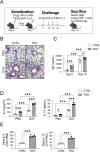This is a preprint.
BLOC1S1 control of vacuolar organelle fidelity modulates TH2 cell immunity and allergy susceptibility
- PMID: 39803487
- PMCID: PMC11722528
- DOI: 10.1101/2024.03.21.586144
BLOC1S1 control of vacuolar organelle fidelity modulates TH2 cell immunity and allergy susceptibility
Update in
-
BLOC1S1 Control of Vacuolar Organelle Fidelity Modulates Murine TH2 Cell Immunity and Allergy Susceptibility.Allergy. 2025 Aug;80(8):2128-2140. doi: 10.1111/all.16461. Epub 2024 Dec 31. Allergy. 2025. PMID: 39737471 Free PMC article.
Abstract
The levels of biogenesis of lysosome organelles complex 1 subunit 1 (BLOC1S1) control mitochondrial and endolysosome organelle homeostasis and function. Reduced fidelity of these vacuolar organelles is increasingly being recognized as important in instigating cell-autonomous immune cell activation. We reasoned that exploring the role of BLOC1S1 in CD4+ T cells, may further advance our understanding of regulatory events linked to mitochondrial and/or endolysosomal function in adaptive immunity. Transcript levels of the canonical transcription factors driving CD4+T cell polarization in response to activation showed that, the TH2 regulator GATA3 and phosphorylated STAT6 were preferentially induced in BLOC1S1 depleted primary CD4+ T (TKO) cells. In parallel, in response to both T cell receptor activation and in response to TH2 polarization the levels of IL-4, IL-5 and IL-13 were markedly induced in the absence of BLOC1S1. At the organelle level, mitochondrial DNA leakage evoked cGAS-STING and NF-kB pathway activation with subsequent TH2 polarization. The induction of autophagy with rapamycin reduced cytosolic mtDNA and reverses these TH2 signatures. Furthermore, genetic knockdown of STING and STING and NF-κB inhibition ameliorated this immune regulatory cascade in TKO cells. Finally, at a functional level, TKO mice displayed increased susceptible to allergic conditions including atopic dermatitis and allergic asthma. In conclusion, BLOC1S1 depletion mediated disruption of mitochondrial integrity to initiate a predominant TH2 responsive phenotype via STING-NF-κB driven signaling of the canonical TH2 regulatory program.
Figures






Similar articles
-
BLOC1S1 Control of Vacuolar Organelle Fidelity Modulates Murine TH2 Cell Immunity and Allergy Susceptibility.Allergy. 2025 Aug;80(8):2128-2140. doi: 10.1111/all.16461. Epub 2024 Dec 31. Allergy. 2025. PMID: 39737471 Free PMC article.
-
High cyclic GMP-AMP synthase and stimulator of interferon genes in cholangiocarcinoma suggest their potential as targets for treatment.PeerJ. 2025 Aug 6;13:e19800. doi: 10.7717/peerj.19800. eCollection 2025. PeerJ. 2025. PMID: 40786100 Free PMC article.
-
Transcriptional co-regulator OCA-B/Pou2af1 restricts Th2 differentiation.Front Immunol. 2025 Apr 29;16:1548636. doi: 10.3389/fimmu.2025.1548636. eCollection 2025. Front Immunol. 2025. PMID: 40364837 Free PMC article.
-
Systemic pharmacological treatments for chronic plaque psoriasis: a network meta-analysis.Cochrane Database Syst Rev. 2021 Apr 19;4(4):CD011535. doi: 10.1002/14651858.CD011535.pub4. Cochrane Database Syst Rev. 2021. Update in: Cochrane Database Syst Rev. 2022 May 23;5:CD011535. doi: 10.1002/14651858.CD011535.pub5. PMID: 33871055 Free PMC article. Updated.
-
Systemic pharmacological treatments for chronic plaque psoriasis: a network meta-analysis.Cochrane Database Syst Rev. 2020 Jan 9;1(1):CD011535. doi: 10.1002/14651858.CD011535.pub3. Cochrane Database Syst Rev. 2020. Update in: Cochrane Database Syst Rev. 2021 Apr 19;4:CD011535. doi: 10.1002/14651858.CD011535.pub4. PMID: 31917873 Free PMC article. Updated.
References
-
- Ryan D. G., and O’Neill L. A. J.. 2020. Krebs Cycle Reborn in Macrophage Immunometabolism. Annu Rev Immunol 38: 289–313. - PubMed
-
- Roy D. G., Chen J., Mamane V., Ma E. H., Muhire B. M., Sheldon R. D., Shorstova T., Koning R., Johnson R. M., Esaulova E., Williams K. S., Hayes S., Steadman M., Samborska B., Swain A., Daigneault A., Chubukov V., Roddy T. P., Foulkes W., Pospisilik J. A., Bourgeois-Daigneault M. C., Artyomov M. N., Witcher M., Krawczyk C. M., Larochelle C., and Jones R. G.. 2020. Methionine Metabolism Shapes T Helper Cell Responses through Regulation of Epigenetic Reprogramming. Cell Metab 31: 250–266 e259. - PubMed
Publication types
Grants and funding
LinkOut - more resources
Full Text Sources
Research Materials
Miscellaneous
